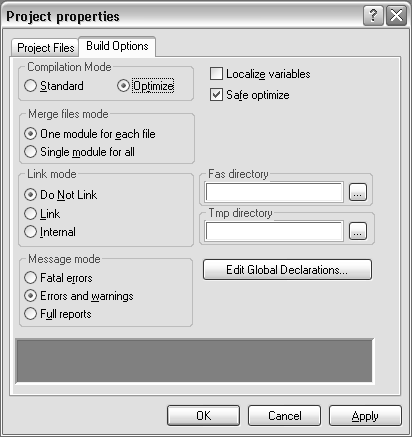VLISP provides a number of options for compiling and linking a project's source code that affect the efficiency of the compiled code. For example, you can specify whether to create a separate FAS file for each source file or merge all compiled files into a single FAS file. You can choose to have the compiler remove the names of all local symbols from your compiled files. You specify these options in the Project Properties dialog box.
To specify project build options
 Open Project from the
VLISP menu).
Open Project from the
VLISP menu). 

Some of the build options require extensive background information, which is provided in the following sections of this chapter. The build options are:
Choose between standard and optimized compilation. Optimized compilation creates smaller and faster programs but is not suited for every project. See Choosing a Compilation Mode for more information on this topic.
Tell the compiler whether to create a separate FAS file for each source file, or to merge all compiled files into a single FAS file.
A single FAS file is faster to load and is required for certain types of optimization. Sometimes, however, you will prefer to load your code one file at a time. This is important if you have not completed the debugging or modification of the application's code. FAS files do not allow source code debugging, so it is recommended that you compile your code only after the initial debugging is done.
Specify how function calls are to be optimized. This option is only available if optimized compilation is selected. Choose from the following:
See Choosing a Link Mode for further information on these options.
If this option is selected, this option directs the compiler to refuse some types of optimization, if there is a chance they will result in incorrect code. For more information on optimization, see Choosing a Compilation Mode below.